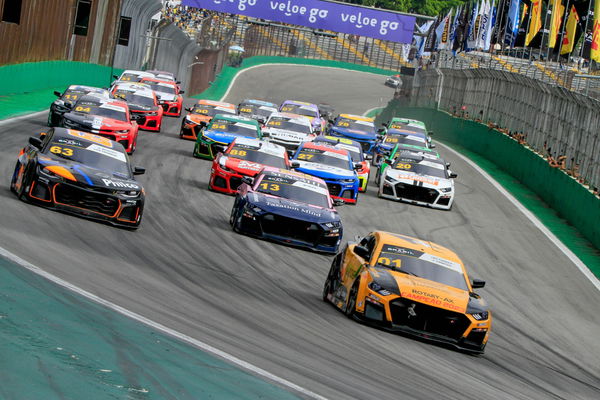

Sunday afternoon used to belong to NASCAR. Back in the good ol’ days, the stock car racing series dominated TV viewership, with fans glued to their screens to watch the likes of Richard Petty, Dale Earnhardt, and Jeff Gordon dominate the racetracks. But something has shifted in recent years. If the 2025 Cup Series campaign is anything to go by, the numbers paint a pretty bleak picture, with viewership taking a significant decline. The culprit might surprise you, as it all comes down to the new media rights deal, which has shaken up the sport big time.
Watch What’s Trending Now!
And even the most high-stakes playoff races couldn’t draw the crowd. The Round of 12 opener at New Hampshire drew just 1.29 million viewers, down a shocking 31% from the same race last year. But the story goes deeper than just a bad time slot. And one question prevails: what’s going on? Is it just the backlash of shifting networks and streaming platforms? One NASCAR insider may know the answer to this.
ADVERTISEMENT
Jordan Bianchi reveals the reason behind the TV decline
Speaking on the Kenny Wallace podcast, Jordan Bianchi broke it down. He said, “Yeah. I mean, there it’s so multi-layered, right? This is like the biggest onion ever with all these. You have to have a streaming component to your..if you’re going to be a sports league now. Like, you have to have a streaming component. That is the future. You have to be on board with that. Pick a sports league, pick a major sports league, and they’re going to have a streaming element to them. NASCAR was slow to adapt to that.”
The core of the argument is that NASCAR was slow to fully embrace streaming, even though the future of major sports leagues is increasingly online. As Bianchi points out, any big league today needs to have a streaming component. While NASCAR did make deals, for instance, Amazon Prime Video now streams five races a year.
But simply having a presence on a streaming service hasn’t been enough to compensate for its declining linear TV audience. In 2025, NASCAR’s Cup Series saw a 14% drop in average viewership compared to 2024. That suggests that just migrating a streaming platform isn’t a silver bullet, especially when access becomes fragmented across too many platforms.
ADVERTISEMENT

Imago
via lusomediausa.com
Moreover, the way NASCAR has fragmented its broadcast rights is creating friction rather than driving growth. This year, its races were spread across six different outlets, from Amazon Prime to FS1 to FOX, USA Network, NBC, and TNT via Max. That patchwork model confuses viewers, particularly casual or newer fans who don’t know where to tune in.
ADVERTISEMENT
This may be pushing fans away, even while younger viewers are gradually adopting the Prime Video broadcasts. In short, NASCAR is technically on board with streaming, but it hasn’t nailed the strategy just yet, and its slow pivot may be hurting its reach more than helping. However, NASCAR President Steve O’Donnell expected this to happen.
But at the end of the day, NASCAR’s ultimate rival is the NFL. In further revealing how the NASCAR TV viewership is affected, Bianchi said, “The other part of that is too; let’s not ignore the elephant in the room. It’s the NFL. The NFL is extremely popular. The NFL and it’s never been more popular than ever before. The numbers for games continue to rise almost on a yearly basis. And so, it’s hard to go against that. And NASCAR largely does hold its own on Sundays. Like, they do deliver a very good number where outside of the NFL, they’re often the number two most-watched sport. So, that’s something to hang your hat on. But there is a ways to go to get that number even higher.”
NFL remains undefeated. The recent NASCAR Cup Series race at Kansas Speedway pulled in 1.41 million viewers, making it the second most-watched sporting event of the weekend, just behind NFL coverage. Even in tighter viewership periods, NASCAR remains a cable powerhouse. The Bristol Night Race averaged 1.536 million viewers, registering as the number two sport on cable behind football. However, NASCAR isn’t here to be number two and still has a long way to go to bring up its numbers. And Bianchi may know the solution behind the decline.
ADVERTISEMENT
Bianchi identifies the root cause of the problem
With the playoff format still being debated and gatekept, the Insider blames the current system for the decline in viewership. Bianchi directly points to NASCAR’s long schedule and its disastrous overlap with the NFL as a major reason the sport is losing viewership. Speaking on the Teardown podcast, alongside fellow journalist Jeff Gluck, Jordan Bianchi didn’t hold back.
Bianchi bluntly says, “38 races, 36 points races, plus 2 exhibitions, is a lot. I am going to reduce the schedule by (removing) second dates at Las Vegas, Kansas, Phoenix, Darlington, Bristol, Atlanta and Martinsville. That puts us down to 29 races. I then would have a floating 30th date somewhere that will be something different, whether that’s Montréal or Mexico City or whatever else.”
ADVERTISEMENT
Fewer races would reduce fan fatigue and also help NASCAR avoid competing against football every fall weekend. The point is clear: NASCAR cannot expect to maintain its status as the second most-watched sport if it keeps placing its biggest playoff events directly against the NFL’s Sunday domination.
Moreover, Binachi wants a trimmed, streamlined calendar. He added, “ We’re also going to move the (season opening) Clash back to Daytona… We talk a lot about how we want to give races a big feel… having the Clash at Daytona, I think we’ll do that.”
Another contributing factor, the elimination-style playoff system, and now, as NASCAR scrambles to piece together a new one for next year, the fans are eagerly waiting for an update on it.
ADVERTISEMENT
ADVERTISEMENT
ADVERTISEMENT

